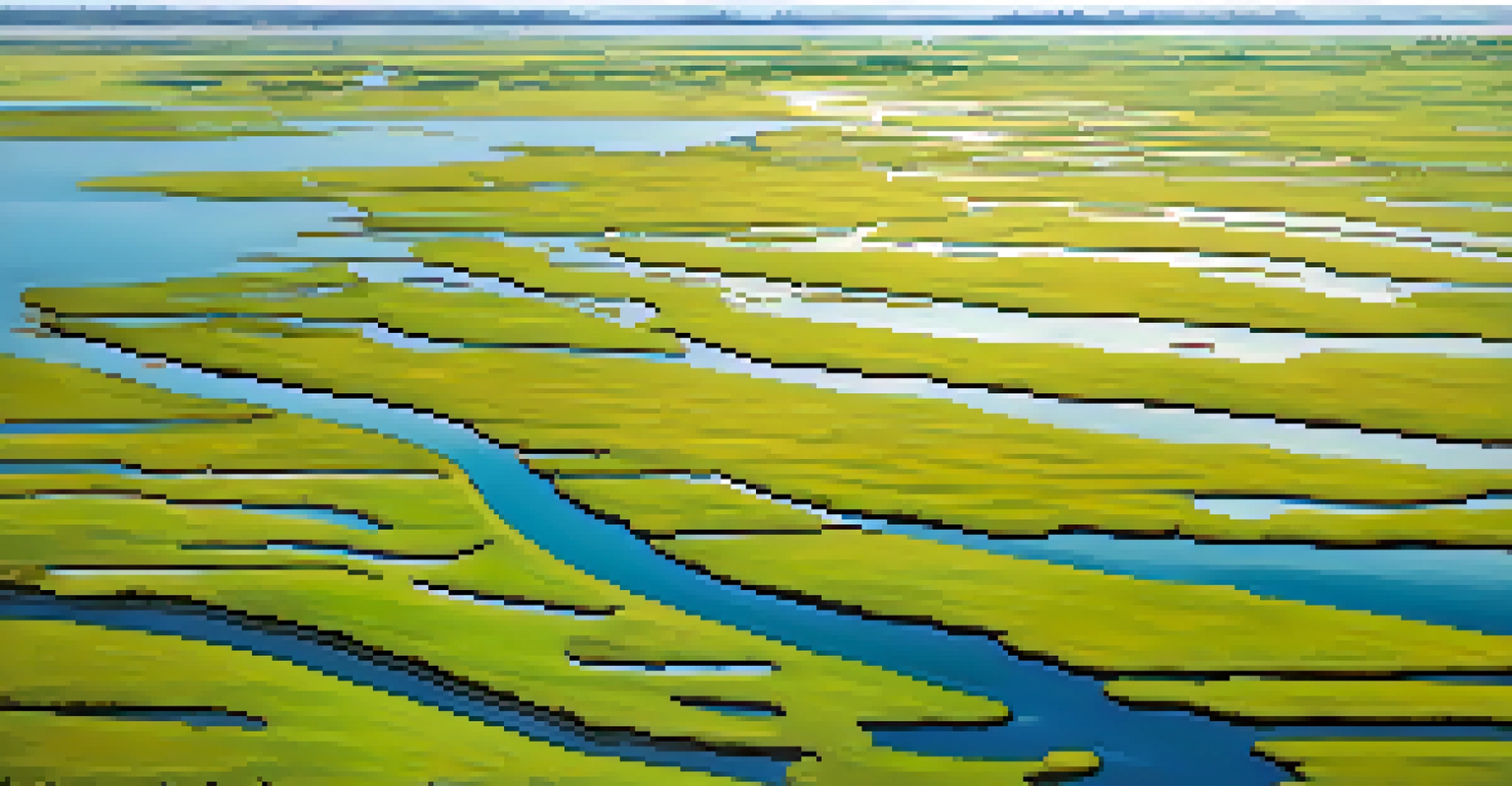North Carolina's Wetlands: Climate Zones and Conservation Needs

Understanding North Carolina's Unique Wetland Ecosystems
North Carolina is home to diverse wetland ecosystems that play a crucial role in the environment. From marshes to swamps, these areas provide essential habitats for wildlife and help in water filtration. The rich biodiversity found in these wetlands supports countless species, some of which are rare or endangered.
Wetlands are among the most productive ecosystems in the world, providing essential services to both wildlife and humans.
Wetlands are not just pretty landscapes; they act as natural buffers against flooding and erosion. They absorb excess rainwater and slowly release it, helping to maintain local water levels. This function is increasingly important as climate change leads to more extreme weather events.
Additionally, wetlands serve as carbon sinks, capturing carbon dioxide from the atmosphere. This process helps mitigate climate change, making the conservation of these areas vital for both local ecosystems and global climate health.
Climate Zones of North Carolina and Wetland Distribution
North Carolina’s climate ranges from subtropical in the east to temperate in the west, influencing the types of wetlands found throughout the state. Coastal wetlands, such as salt marshes, thrive in the eastern region, while freshwater swamps and bogs are more common inland. Understanding these climate zones is key to effective wetland management and conservation.

The variations in climate also affect plant and animal life in these wetlands. Species that thrive in warmer coastal areas may struggle in cooler mountainous regions. This diversity means that conservation efforts must be tailored to specific local conditions to be successful.
Wetlands Support Wildlife Diversity
North Carolina's wetlands are vital ecosystems that provide habitats for a wide range of species and maintain ecological balance.
As climate change continues to impact weather patterns, the distribution of these wetlands may shift. This makes ongoing research and monitoring essential to ensure that conservation strategies adapt to these changes and continue to protect vital ecosystems.
The Importance of Wetlands for Biodiversity
Wetlands are some of the most productive ecosystems on the planet, often referred to as 'biological supermarkets.' They provide food and shelter for a wide range of species, from amphibians and birds to fish and invertebrates. This biodiversity is not only beautiful but also essential for ecological balance.
The health of our wetlands is directly tied to the health of our communities, making their conservation a priority for sustainable development.
Many species rely on wetlands for breeding grounds and as a source of food. For instance, migratory birds depend on these areas during their long journeys, making wetlands critical for their survival. Protecting these habitats is vital to maintaining the delicate balance of our ecosystems.
Furthermore, the health of wetlands directly impacts surrounding environments. Healthy wetlands filter pollutants and improve water quality, benefiting both wildlife and human populations. This interconnectedness highlights the need for robust conservation efforts.
Threats Facing North Carolina's Wetlands
Despite their importance, North Carolina's wetlands face numerous threats. Urban development, agriculture, and pollution are leading causes of wetland degradation. As cities expand and farmland increases, many wetlands are drained or filled, resulting in habitat loss.
Additionally, climate change poses a significant risk to these ecosystems. Rising sea levels can inundate coastal wetlands, while changing precipitation patterns can alter freshwater wetlands. These shifts not only threaten plant and animal species but also disrupt the essential services wetlands provide.
Climate Change Threatens Wetlands
Rising sea levels and changing weather patterns due to climate change pose significant risks to the health and distribution of wetlands.
Invasive species further complicate the conservation landscape. Non-native plants and animals can outcompete native species, leading to declines in biodiversity. Addressing these threats requires a coordinated effort from communities, policymakers, and conservationists.
Conservation Efforts in North Carolina
Recognizing the importance of wetlands, North Carolina has implemented various conservation strategies. Programs aimed at wetland restoration and protection are underway, focusing on both public and private lands. These initiatives often involve partnerships between government agencies, NGOs, and local communities.
One successful example is the North Carolina Wetlands Restoration Program, which aims to restore and enhance degraded wetlands. By reintroducing native plants and removing invasive species, these efforts help to revitalize ecosystems and support wildlife populations.
Community engagement is also a key component of conservation efforts. Educating the public about the value of wetlands fosters a sense of stewardship and encourages local involvement in preservation initiatives. Every small action counts in the fight to protect these vital ecosystems.
The Role of Policies and Legislation
Effective conservation of North Carolina's wetlands relies on strong policies and legislation. The Clean Water Act is a federal law that plays a significant role in protecting wetlands across the country, including North Carolina. This legislation regulates discharges into waters and requires permits for activities that may impact wetland areas.
At the state level, North Carolina has its own set of laws aimed at protecting wetlands, such as the North Carolina Wetlands Conservation Plan. These policies provide a framework for managing and preserving wetland resources while balancing development needs.
Community Engagement is Crucial
Involving local communities in conservation efforts fosters stewardship and helps protect North Carolina's valuable wetland ecosystems.
However, challenges remain in enforcing these laws and ensuring compliance. Continued advocacy and public awareness are essential to strengthen protections for wetlands and promote sustainable practices that benefit both people and the environment.
How You Can Get Involved in Wetland Conservation
Everyone can play a part in conserving North Carolina's wetlands, regardless of their background. Simple actions, like reducing water usage and properly disposing of waste, can help minimize pollution and protect these ecosystems. Being mindful of your impact on local waterways is a significant first step.
Joining local conservation organizations or participating in community clean-up events can also make a difference. These groups often lead initiatives focused on wetland restoration and education, providing a platform for individuals to contribute their time and skills.

Advocating for policy changes and supporting legislation that protects wetlands is another way to get involved. By staying informed and voicing your support, you can help ensure that these vital ecosystems receive the attention and protection they deserve.